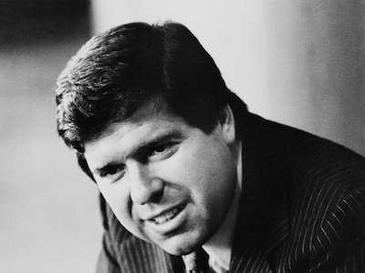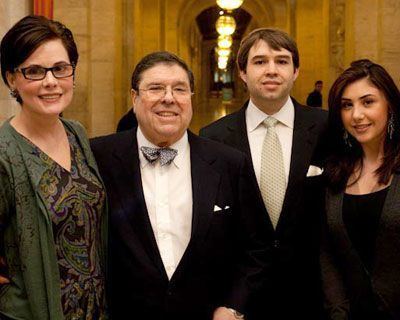Name Saul Steinberg | Alma mater The Wharton School Role Businessman | |
 | ||
Full Name Saul Phillip Steinberg Spouse(s) Barbara Herzog (?–1974; divorced)Laura Sconocchia Fisher (1974–?; divorced)Gayfryd McNabb MacLean Johnson (1983–2012; his death) Children Laura Steinberg, Jonathan Lawrence Steinberg Similar People Maria Bartiromo, Jonathan Tisch, Michael Steinhardt, Preston Robert Tisch, Joan Tisch | ||
Saul Phillip Steinberg (August 13, 1939 – December 7, 2012) was an American businessman and financier. He started a computer leasing company (Leasco), which he used in an audacious and successful takeover of the much larger Reliance Insurance Company in 1968. He was best known for his unsuccessful attempts to take over Chemical Bank in 1969 and Walt Disney Productions in 1984.
Contents

Background
Steinberg was born to a Jewish family on August 13, 1939, and grew up in Brooklyn, New York the son of Julius and Anne Cohen Steinberg. He has one brother, Robert Steinberg, and two sisters, Roni Sokoloff and Lynda Jurist. Steinberg finished a degree from Wharton School of the University of Pennsylvania in Philadelphia. He was listed as a member of the class of 1959 although some accounts have said that he graduated in two years at age 18.
Business career
In 1961, at the age 22, Steinberg founded Leasco Data Processing Equipment Corporation, a computer leasing company that leased IBM computers. While at Wharton, Steinberg had written a paper about IBM Corp., and he had learned that IBM was charging premium prices to lease its computers. Steinberg discovered that he could offer computer leases that would undercut IBM's prices and still obtain bank financing for the entire purchase price of the computers by using the signed leases as collateral with lenders. Leasco grew rapidly, and in 1965 went public.
Leasco bid to acquire Reliance Insurance Company, a Philadelphia insurance company 10 times the size of Leasco. Reliance had been in business 150 years, having been established in 1817 to provide fire insurance. It was managed conservatively. Insurance companies have lots of capital, which is just what computer leasing companies need. Steinberg offered the Reliance shareholders a combination of convertible subordinated debentures and common stock warrants (rather than cash). Reliance management resisted but eventually capitulated, and Leasco was successful in assuming control of Reliance in 1968. Steinberg was 29 when he took over Reliance.
In 1969, Steinberg attempted to take over Chemical Bank, then one of the nation's largest financial institutions. The attempt failed.
Steinberg became the CEO of Reliance, and he and his brother were the senior managers of Reliance for the next thirty years. Steinberg took on large amounts of debt during the junk bond era and grew, apparently by underpricing its insurance policies. The company paid out dividends to the shareholders, including the Steinberg family members as major shareholders, and paid Saul Steinberg large sums in compensation.
At Reliance, Steinberg hired dealmaker Henry Silverman, who would later become the CEO of HFS Inc. and later Cendant Corp. In 1986, while Silverman was at Reliance, he and Steinberg were involved with television executive, Joseph Wallach, in acquiring Spanish language television stations, and creating the Spanish-language media company, Telemundo.
In 1995, Steinberg had a serious stroke. He was forced to step back from management of Reliance. The leverage, low pricing on insurance policies led Reliance to financial problems. Management attempted to sell the company. Reliance Group negotiated a transaction to be sold to Leucadia National in 2000 for stock and the assumption of debt. However, this transaction fell apart in July, 2000.
Reliance filed for bankruptcy in 2001 and entered into a long process of liquidation. Steinberg was forced to sell his extensive art collection along with his 17,000 square-foot, 34-room duplex apartment at 740 Park Avenue in Manhattan, which was bought for $37 million by Stephen A. Schwarzman of The Blackstone Group.
Involvement with Wharton
Steinberg was a major benefactor of the Wharton School at the University of Pennsylvania. He served as chairman of Wharton's Board of Overseers for over 15 years and continued as a member of the board until his death. The Steinberg name is highly visible at Wharton, most notably attached to Steinberg-Dietrich Hall, which served as the main undergraduate building, containing classrooms, lounges, computer labs, and departmental offices. The Steinberg Conference Center serves as home to the Executive Education Center and the Aresty Institute of Executive Education. Additionally, Steinberg endowed the Saul P. Steinberg Professor of Management chair.
Family and personal life
In 1989 Steinberg hosted an opulent 50th birthday party for himself, that included live models depicting his favorite Renaissance paintings.
Steinberg's brother, Robert, also known as "Bobby," served as a senior executive at Reliance and played a significant role in managing the company alongside Steinberg for many years. In 1999, during a period of critical financial challenges for Reliance, Saul Steinberg dismissed his brother from the company, leading to a rift between them. The following year, in 2000, their mother, Anne Steinberg, filed a lawsuit against Saul, demanding the repayment of $5 million she claimed to have loaned him in 1997 with the agreement it would be repaid by December 1999. Additionally, Anne Steinberg pursued legal action against her son Robert over a $1.5 million debt, which was also due to be settled in December.
In 2000 Steinberg sold his apartment at 740 Park Avenue in Manhattan to financier Stephen A. Schwarzman of The Blackstone Group for a reported $37 million. The apartment had once belonged to John D. Rockefeller, Jr..
Steinberg died on December 7, 2012 at the age of 73, on the very same day as his mother, Anne Steinberg.
Charitable Gifts
In 2000 Steinberg donated a large painting, The Death of Adonis (1614), by Peter Paul Rubens, to the Israel Museum in Jerusalem.
